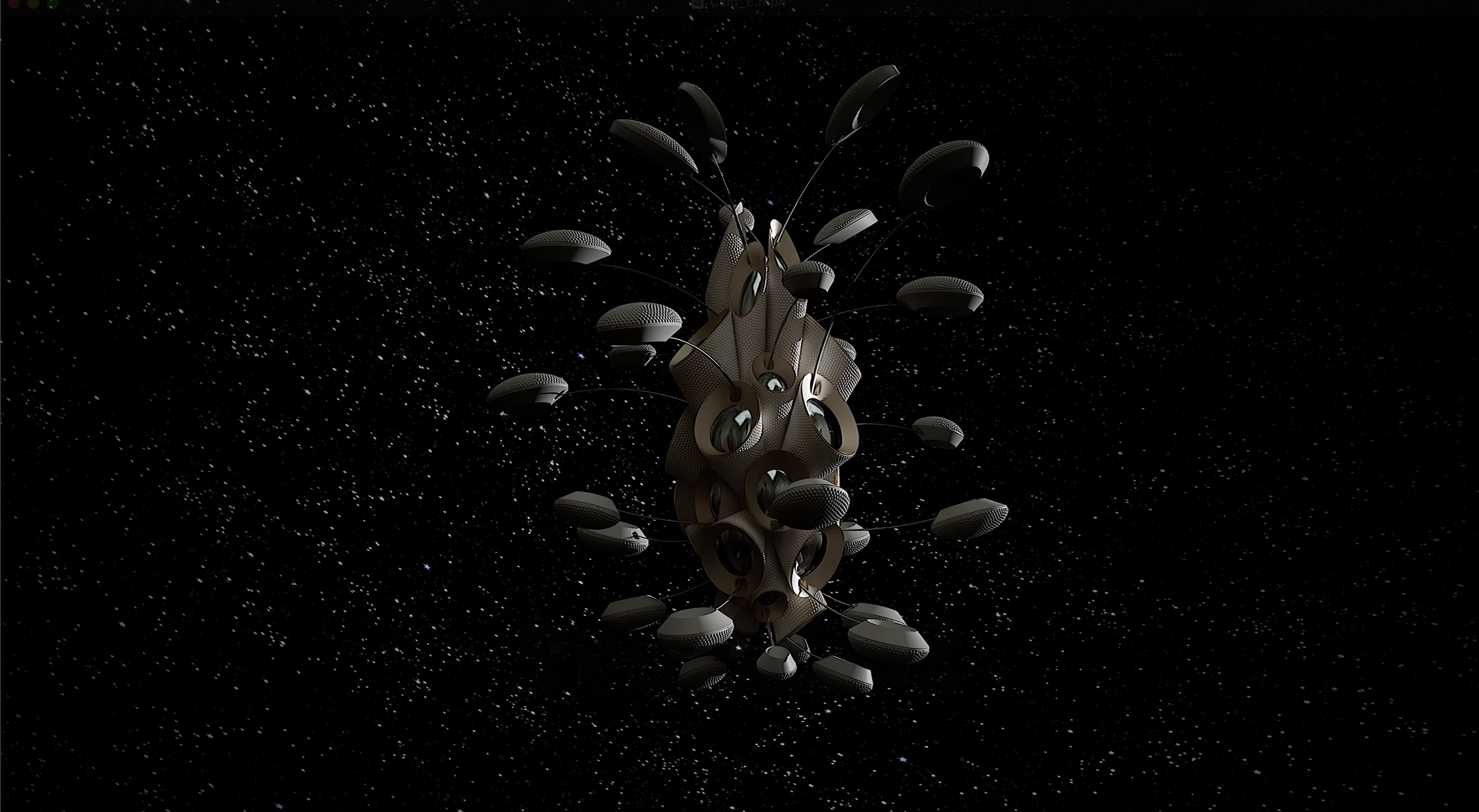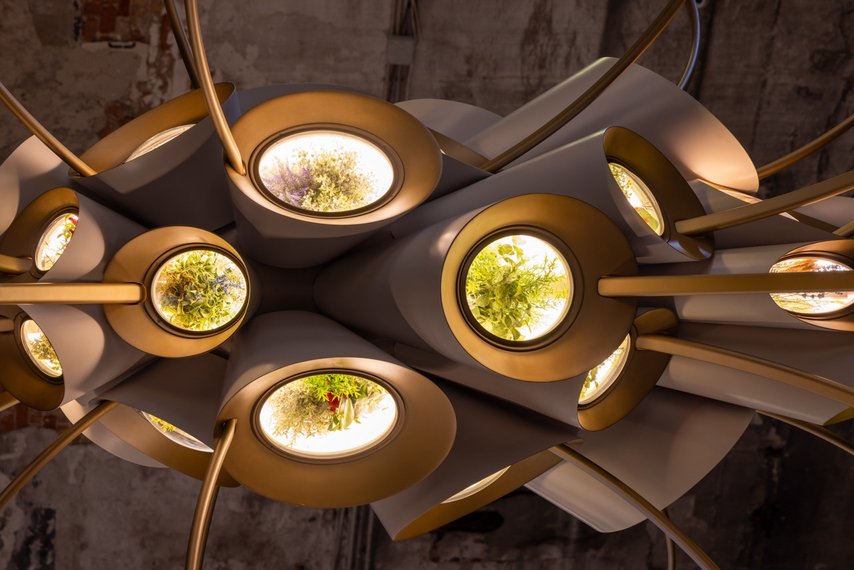
The Space Garden’s design features 30 growth chambers (referred to as ‘lobes’) arranged around a central growth chamber — each containing a different plant species along with the equipment needed to help them thrive.
Each lobe attaches to the central chamber and flares outward, culminating in a 1-inch-thick curved pane of fused silica, or ‘lens’, inset into the lobe’s outboard end. This end is equipped with a shield, or ‘cap’, connected to a telescoping truss, which can deploy the cap outward to allow sunlight into the lobe, and can retract to cover the lens when natural light is not desired or to protect the lens from micrometeoroid / orbital debris impact.
Inside each lobe, an array of equipment is designed to support a variety of plant species throughout their growth cycles.
-
A ring of mounting adapters around the lens (outboard end of lobe) accommodates an array of grow lights, fans, and sensors that monitor above-ground plant growth. These sensors include multispectral / hyperspectral cameras, a CO2 sensor to maintain optimal levels for photosynthesis (400–5,000ppm), an O2 sensor to monitor oxygen produced by plants and prevent hyperoxic conditions, an ethylene detector to avoid growth inhibition, a temperature and humidity sensor, and a light sensor to measure photosynthetically active radiation.
-
A near-infrared (NIR) camera monitors canopy health and biomass accumulation. A hyperspectral camera is able to detect crop stresses via reflectance and fluorescence imaging in visible and near-infrared wavelength range. Specifically, hyperspectral cameras can provide inputs to ML models which detect plant stress before visible symptoms arise.
-
The growth container is shaped to allow forced-air circulation, supplied from the central chamber through a 1-inch gap between the lobe’s hull and container, circulated around the crop growth area via ring-mounted fans, and pulled down through a larger fan mounted within the container’s central opening. Fans will maintain an airflow of 0.3 to 1.5 meters per second to simulate convective currents.
-
Mounted, directional LED rings will provide spectral flexibility (red: 630–660 nm, blue: 400–500 nm, far-red: 730–750 nm) and intensity, up to 1,000 µmol/m²/s). Through the use of these LED rings, targeted spectral parameters for each crop will be used to reduce electrical energy requirements.
Space Garden’s 30 lobes are supported by biome-level and spacecraft-level systems, which maintain optimal growth conditions for the project’s plant occupants. Systems are informed by Daikin Industries, the world’s leading experts in air and water quality.
-
Air revitalization for each lobe is primarily driven by removing plant produced oxygen and ethylene as well as transpired water vapor from each lobe and adding carbon dioxide. To accomplish this, carbon dioxide from the central Space Garden compressed carbon dioxide tanks is driven into the lobe around the outside of the root zone while existing lobe air is pulled out by the lobe air removal fan located in the middle of the root zone. Lobe circulation fans ensure that air within the lobe is well mixed and air pockets dead zones are avoided. After air is circulated out of each lobe, it is sent through a HEPA filter and activated charcoal bed. With a six year lifetime for these HEPA filters, this system should sufficiently filter out volatile organic compounds and particulates for the lifetime of Space Garden.
-
Sources of heat that need to be considered for the Space Garden ECLS system include the LED rings, electronics, pumps, and external sources. Similarly, plant transpiration will cause humidity build up in lobes. Both heat and humidity will need to be removed from the air in order to keep each biome within its respective temperature range. Each Space Garden biome will have a condensing heat exchanger (CHX) that will control relative humidity and temperature for the biome.
-
A unique space ECLS technology that Space Garden will explore is the use of a fuel cell to convert H2 and crop produced O2 into water and electricity. H2 will be provided to the system via a compressed H2 tank and O2 will be separated from the ECLS airstream after moving through the condensing heat exchanger. This fuel cell enables a much more circular Space Garden ECLS system and also produces electricity for LED lighting and on-board electronics.
-
At Space Garden’s activation, all water for crop initialization will be sourced from a central tank of water sent up at launch. From then on, a water loop will be established with Space Garden to water plants from collected liquid water condensed from humidity and water produced by the Space Garden’s fuel cell. The central water tank will distribute water throughout the Space Garden and each lobe will have a control valve to ensure its crops receive the proper amount of water.
Space Garden is made possible through the collaboration of our partners:
Heatherwick studio is a team of over 250 problem solvers dedicated to making the physical world around us better for everyone. Based out of their combined workshop and design studios in London, Shanghai, and California, they create buildings, spaces, objects and infrastructure. They want to see a world where the buildings and places around us are radically more joyful, engaging and human.
With a century of expertise pioneering energy-efficient heating, ventilation and air conditioning (HVAC) technologies, Daikin is applying its core philosophy of collaborative innovation to explore new opportunities to deliver HVAC solutions that meet the unique demands of space. Aurelia and Daikin will work together to explore groundbreaking approaches to air and water management for the next hundred years, on Earth and in orbit.
Serving clients in every major financial center, Skadden is one of the world’s leading law firms, with 22 offices and approximately 1,700 attorneys. The firm’s diversified practice enables it to offer solutions to the most challenging legal issues in virtually every area of corporate law. With more than 50 distinct areas of practice, the firm’s attorneys provide a broad range of legal services across a spectrum of industries.







